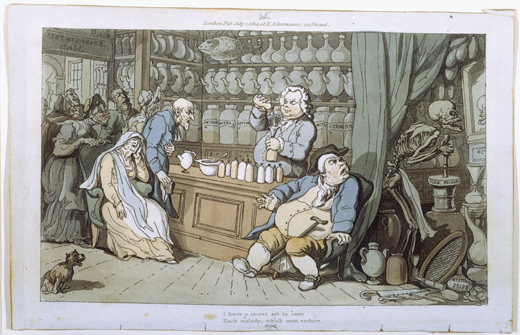The Quack Doctor
Thomas Rowlandson, 1814
 Hand coloured etching and aquatint, entitled 'The Quack Doctor', drawn and etched by Thomas Rowlandson and published by Rudolph Akermann in 1814.
Hand coloured etching and aquatint, entitled 'The Quack Doctor', drawn and etched by Thomas Rowlandson and published by Rudolph Akermann in 1814.
While a satire on the dubious nature of medicine in the early 1800s, 'The Quack Doctor' also depicts the public interior of an apothecary shop and the equipment in use at the time. The apothecary in 'The Quack Doctor' is shown standing behind the dispensing counter, decanting a liquid into a medicine bottle via a funnel. Behind the counter are shelves of carboys, wet and dry drug jars (all labelled with poisons: CANTHARI, ARSENIC, OPIUM, NITRE, VITRIOL), and a drug run. More bottles, a small composition mortar and pestle, and a wet drug jar line the counter.
Over the doorway is painted "Apothecaries Hall". Patients crowd in and one is startled to see, behind a curtain, that the apothecary's assistant is a skeleton mixing a preparation in a large bell metal mortar labelled 'SLOW POISON'.
Below the drawing is lettered, "I have a secret art to cure, Each malady which men endure".